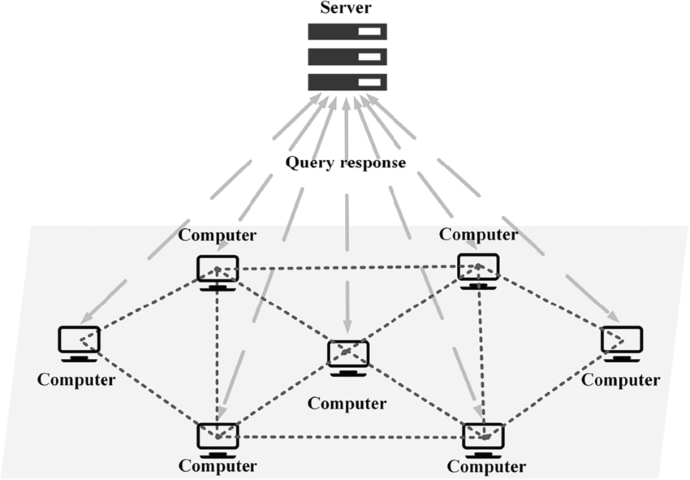P2P File Sharing System
Development of a P2P file sharing system with a logger using ONC-RPC and a C-based server (indexer), a Python Web Service, and a Python client.
About the project
This project was developed as the final assignment for the Distributed Systems course. The objective was to build a distributed system that allows users to share files among peers.
The system consists of several components:
- A main server acting as an indexer.
- An RPC server (logger) that records user actions and maintains an auditable log external to the main server.
- A web service providing current date and time.
- A client that allows users to interact with the server and each other to share files.
The full project can be found in the following GitHub repository.
System architecture
RPC Service (Logger)
Acts as a central logging system, capturing and storing all user operations. Implemented in C using the ONC-RPC model, it ensures consistent interfaces for requests/responses and provides effective auditing.
Server
Handles all interactions within the system: registration, connections, and content publishing. Implemented in C as a multithreaded concurrent server using TCP sockets, it supports multiple concurrent client connections.
Web Service
Provides the current date and time for clients to timestamp their operations. Implemented in Python, it can be deployed locally or remotely, returning data as strings for easy integration.
Client
Enables users to issue commands to interact with the server, publish files, and download files directly from peers. Implemented in Python, it operates via a command-line interpreter and also manages direct P2P connections. In P2P mode it behaves as a multithreaded server, supporting multiple simultaneous file transfers.
Message structure by component
Messages follow the course specification: all error codes are 8-bit integers, while other data is sent as strings terminated by \0. Since communication is handled byte by byte, no endianness conversion (ntoh/hton) is required.
RPC Service (Logger)
Messages are strings containing username, executed operation, and timestamp. The RPC server responds with a status code (0 = success, -1 = error).
Server
Uses a TCP-based protocol with messages like REGISTER, UNREGISTER, CONNECT, DISCONNECT, PUBLISH, DELETE. Each request includes the command, timestamp, and username, plus additional parameters (e.g., filename). Responses are 8-bit status codes, sometimes followed by extra data (LIST USERS, LIST CONTENT).
Web Service
Handles a single request: return date and time in string format via HTTP. Implemented with SOAP/XML for structured messaging.
Client
Communicates with the server using the above TCP-based protocol. Commands include:
REGISTER, UNREGISTER, CONNECT, DISCONNECT, PUBLISH, DELETE, LIST_USERS, LIST_CONTENT.
Clients can also directly communicate via P2P (TCP) using the GET_FILE command. File transfers are performed byte-by-byte to ensure integrity.
Application protocols
Client–Server
Communication follows a client-server, request-response model over TCP:
- Connection: client opens a TCP connection.
- Request: sends command and arguments.
- Processing: server executes logic, interacts with RPC Logger if needed.
- Response: server sends status + optional data.
- Disconnection: connection closes (not persistent).
This design saves resources but does not detect abrupt client disconnects (suggested improvement: implement heartbeats).
Client–Client (P2P)
Peers connect via TCP to transfer files. Clients obtain peer IP/port from the central server.
Steps: connection, request (file name), file transfer, confirmation, close.
TCP ensures reliability to prevent file corruption.
Server–RPC Logger
Communication uses ONC-RPC. The main server performs remote calls to log actions transparently, as if calling local functions.
Client–Web Service
The web service exposes a SOAP interface over HTTP. The client requests date/time for timestamping operations.
Compilation & execution
The project includes a setup.py script to automate compilation and execution.
Options:
--clean|-c: clean generated files.--build|-b: compile server, RPC service, and install dependencies.--run|-r: run RPC service, web server, and server.
Typical usage:
1
$ python3 setup.py -cbr
This performs a clean build and runs all services. Clients are then executed separately.
Test suite
Unit tests were implemented using Python’s unittest and unittest.mock for simulating responses. Real processes were also launched for concurrency testing.
test_client_invalids.py
Verifies client behavior under invalid inputs and server errors. Uses socket and web service mocks.
test_client_valids.py
Valid client operations tested with mocks and controlled responses.
test_multiclient.py
Tests concurrency with multiple clients and real server processes. Includes concurrent downloads and registrations.
test_server.py
Covers server-side behavior with real processes. Includes registration, connection, publication, deletion, listing, and disconnection, plus failure cases.
Additional considerations
Potential improvements:
- Better client feedback (progress bars, clearer error messages).
- Stronger security (access controls, encryption).
- Server persistence (store state in files instead of memory).
- Cleaner component modularization (avoid tight coupling during compilation).
- Heartbeat mechanism for client liveness detection.
Conclusion
This project was a challenging and rewarding exercise that put into practice nearly all concepts from the Distributed Systems course.

